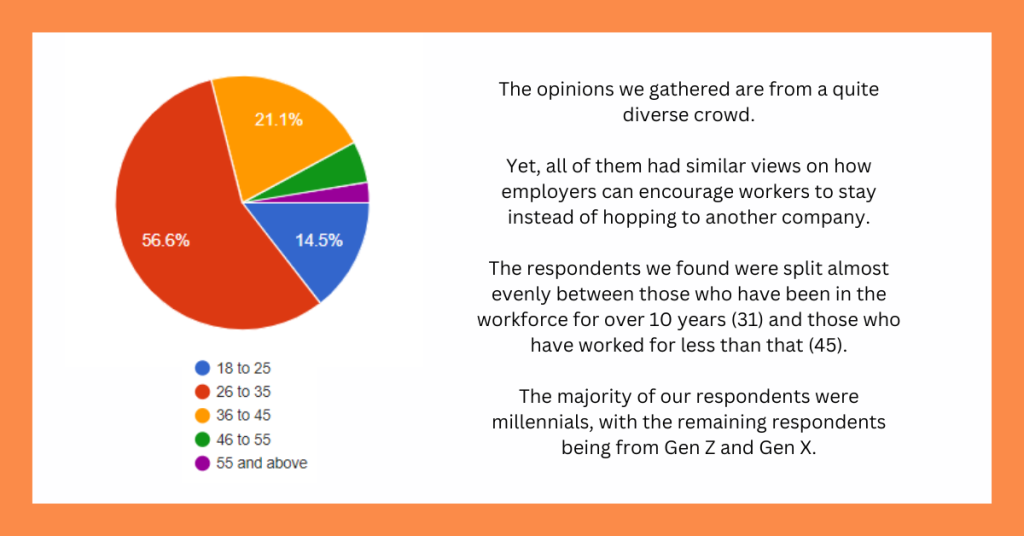Company loyalty versus job hopping, which boat are you in?
It’s been a hot topic lately with plenty of people debating it online after the unexpected layoffs that have been happening at notable international tech companies like Google, Twitch, and even Singapore’s Lazada.
Generally, the consensus is that there are pros and cons to both. But global trends in recent years indicate growing interest in job hopping, particularly amongst Gen Z and millennial workers.
With more of them joining the job market, we came up with a survey to better understand how employees in Malaysia view company loyalty and job hopping. Through this, we found 76 workers wo were willing to share their unfiltered opinions about this.

So…how do employees in Malaysia really feel about this topic?
The results were exactly what you’d expect—everyone rooted for job hopping. And their reasons simply boil down to it giving them better career prospects.
All of our respondents agreed that the only way to move upwards professionally and financially is to job hop. Some who have personally job hopped before shared that they’ve gotten bigger pay raises, better employee benefits, and developed a wider skill set.
So how can employers in Malaysia combat this other “pandemic” and stop the cycle of losing good employees?
We turned to our respondents for their opinions on just what companies can do to make them stay:
1. Set out clearly defined career paths for every position
This may be a no-brainer to some, but our survey found that most of respondents want clearly defined career paths.
For context, career paths are basically a structured framework that outlines different career advancement opportunities available to team members within an organisation. In other words, it gives employees a roadmap for where they can go and how they can get there.
According to Factorial (a UK HR software company), this structure helps employees have a better understanding of the skills and experiences they need for the roles they’re expected to fill.
By outlining an employee’s opportunities for career advancement in the organisation, they may find a greater sense of direction and purpose in the company. This, in turn, can convince them to stick around.
2. Nurture your existing talents and help them grow professionally

In line with the first point, workers are also looking for companies that will assist them to upskill and gain more industry knowledge. The easiest way to do this is by providing relevant industry training, either through in-house coaching or external courses with professional certifications.
One of the survey respondents even suggested a mentorship programme with those higher up the company ladder. This is a practice that many Fortune 500 companies offer their employees as it helps to boost performance.
However, it’s worth noting that a Harvard Business Review experiment found that mentorship programmes only work when they’re made mandatory. This is because if mentoring is optional, employees who need it most may decline the opportunity.
“It could be that low performers are insecure and shy and so are reluctant to participate,” the report stated.
By training and developing employees, they’ll come to feel that companies value their talent and will put in the effort to retain them. This could later attract new talents as well.
3. Being stuck in the same job can suck, so provide opportunities for job rotation

Another point that many of our survey respondents brought up was wanting to explore their interests through job rotation within the company.
Indeed describes job rotation as a working custom that involves moving employees to a new role. This can be either on a set basis or a more regular period. The arrangement is usually temporary, and workers may return to their original positions after some time.
It might seem like a complicated process, but the point of all this is to develop flexible employees. Transitioning between different roles allows workers to gain exposure to various departments while simultaneously improving their skill sets.
To employees, it’s also a way to break up their cycle of monotonous work. Sometimes you’d even find that they’re better equipped to handle another role, thereby improving their job performance and satisfaction too.
4. Develop not just a good company culture, but a great one
Company culture has become quite a buzzword these days.
Essentially, it’s a shared set of workplace beliefs, values, attitudes, standards, and behaviours. It reflects both the written and unspoken rules that people within the organisation follow.
According to our survey respondents, a key thing they look for in company culture is having healthy communication. This includes two-way discussions between management and employees, where opinions from both sides are valued and taken into consideration.
Besides that, some respondents also mentioned wanting transparency in the organisation. So whether the business is thriving, going downhill, or facing some financial setbacks, they want to be kept in the loop. But of course, you don’t have to get into the nitty-gritty details that are P&C.
Together, this can help employees build trust and improve workplace relationships which can solidify employee loyalty.
5. Don’t be too strict, provide more flexible working arrangements

By now, it’s no secret that employees these days are looking for the option to work from home. In fact, a survey Business Today published in November 2023 found that Malaysian workers prefer hybrid working arrangements.
The report stated that employees in hybrid working arrangements felt more engaged and included, and a majority of employees intended to stay three years or longer.
Most of our survey respondents also echoed this sentiment.
Some have even expressed wanting more flexibility in terms of deciding when and where they work. Companies are already starting to give this perk to their employees, as long as they’re assured that everyone still gets their tasks done on time.
It also shows that you care about their wellbeing and encourage work-life balance.
6. Money talks, so start giving out better salary increments
There’s only so much a company can do to retain employees without money coming into the picture, so there’s no point in avoiding it.
The reality is that financial factors play a major role in why people job-hop. Some of our survey respondents even shared that they’ve gotten up to 65% increment in their most recent jump.
Another respondent who has job hopped six times in 10 years said that most employers provide at least a 15% increase from your last salary. In comparison, the usual annual salary increment is around 4% to 6%.
Hence, our survey participants want employers to start matching salary increments with the standard increments given to those who job-hop. Imagine how you’d feel if a newcomer gets a higher pay than you for the same workload.
If this isn’t possible due to company size, then they could consider having more frequent salary revision periods (from annual to bi-annual). The goal is to show monetary appreciation to employees, because at the end of the day, a pizza party won’t help them pay the bills.
7. Benefits shouldn’t be stagnant, they need to increase over time

Last but not least, our survey found that employees highly value the benefits and remunerations a company offers, such as annual leaves, healthcare insurance, wellness allowances, and fuel allowances.
However, these perks cannot remain stagnant. They should gradually increase in value over time.
For example, employees who have been with the company for more than 10 years should get better career development opportunities and be entitled to higher healthcare coverage.
A few of our survey respondents even suggested a 13th-month pay after serving the company for a set number of years. It’s an extra paycheck that is typically equal to one month’s basic salary that’s not as common here, but mandatory in countries like Indonesia, and the Philippines.
So even in the smaller details like these, employees want to know that their needs will be taken care of.
-//-
Of course, this in no way represents all workers in Malaysia, but the agreement across all age groups that we’ve surveyed is that these steps do encourage employee retention.
While many of these points aren’t overnight changes, companies have to start building a more inviting workplace for its people. Fail to do so and you risk a high turnover rate and a waste of resources in training new hires who probably won’t stay long either.
But don’t just take it from us—there are professional resources out there that can help you build a company that better retains its employees and provides them with high job satisfaction. So, go forth and earn your employees’ loyalty.
- Read articles we’ve written about Malaysian startups here.
Also Read: Scientex is on a mission to prove that young M’sians can afford landed homes in urban areas
Featured Image Credit: Vulcan Post










